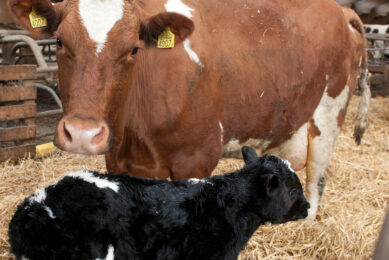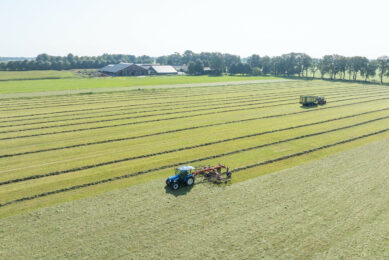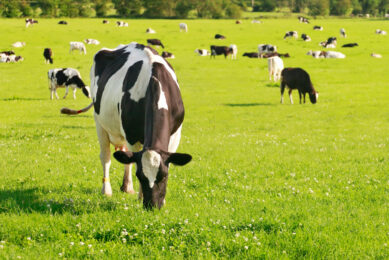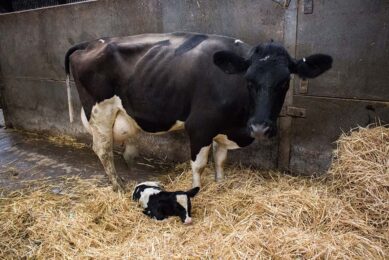Grassland management brings substantial profit
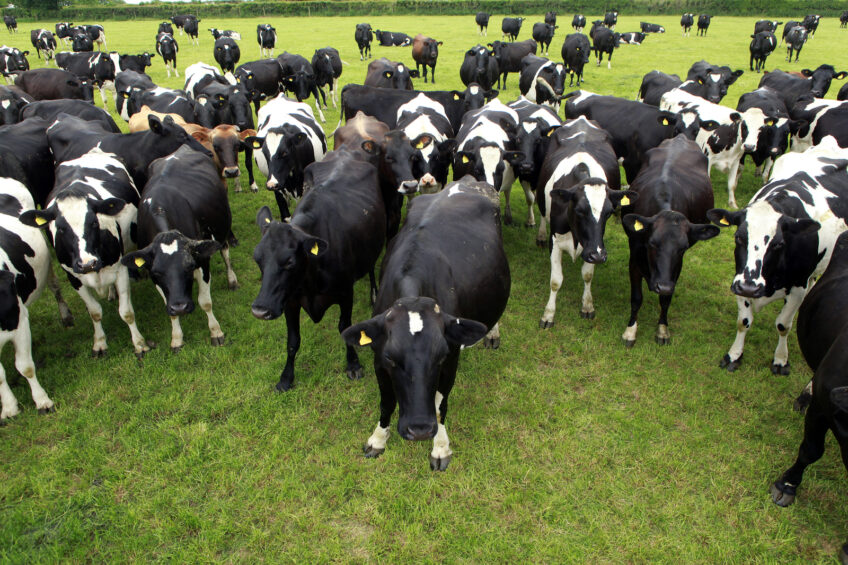
Mark en Matt Pilkington in Rugby (UK) work with autumn-calving cattle to maximize the use of rampantly growing grassland. Their cost price is 28 cents per kilo, including labour costs. In recent years their profit was more than € 200 k.
“The good part of being really involved in grassland management is that you must make decisions every day,” says British dairy farmer Matt Pilkington, while walking through a pasture with considerable speed measuring grass heights every meter or so. “I can estimate the quantity of dry matter in a parcel with an accuracy of 100 kilogrammes (kg). I only use the grass level meter once in a while to calibrate myself and to teach employees to estimate grass height.” No wonder he knows how to estimate grass. Over a three-year period Matt determined the grass condition of all his 45 pastures every Monday.
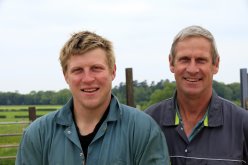
Profile
Company: Matt (26) en Mark (52) Pilkington, Rugby (UK). 450 dairy cows, 280 female young cattle and 90 rosé bulls on 220 ha grasslands (130 ha for grazing). Lease: €70.000/year. Production in 2012: 6.155 kilogrammes (kg) milk per cow, 4,63 % fat, 3,47 % protein on 1.300 kilogrammes concentrates. 180 kilogrammes N is spread in addition to manure. Two permanent employees and on-call worker. Strategy: Low costs by maximum use of grass.
Grass is the production factor at the farm which implemented a low cost strategy and milks about 450 cows. Everything is aimed at using grass as efficiently as possible. Raise the subject of grass with Matt and his father Mark and they instantly become enthusiastic. “2012 was a tough year with a wet summer and an extremely wet autumn,” says Mark. “When 180 kg of pure nitrogen was spread as fertiliser, this resulted in an average growth of 9.3 tonnes dry matter per hectare, 7,700 kg of that is used by the cows. We annually sell 500 tonnes of silage maize. In 2012 we used 1,300 kg concentrated feed per cow; which accounts for almost 6,200 kg of milk per cow. It is our aim to produce 10 tonnes dry matter per hectare using the same amount of fertiliser, of which we will use 8,400 kg. In turn reducing the amount of concentrated feed provided to 1,100 kg per year with a milk production of 6,500 kg.”
Fertility is crucial
The objectives are clear, but how can they be achieved? “At our farm TMR does not only represent Total Mixed Ration, it also means Target, Monitor and React,” Matt grins. Beginning with treating all cows equally. This is possible as the company works with ‘block calving’: 80% of cows calve within the six weeks after the 20th of August, followed by the rest in the five subsequent weeks, so that all cows have calved before November. Cows in heat are inseminated between November 12th and Christmas. Then 12 Aberdeen Angus bulls join the cows until the 12th of February: four days rest after two days in the field. “Good fertility is essential to the system’s success. This means we should not keep offspring of the cows that do not keep the rhythm. That is why a beef bull is used,” says Mark.
The strategy works well. When the cows are checked 45 days after removing the bulls, 91% prove to be in calf. The average calving interval is 364 days.
Short winter period
The cows are moved to the stables by the end of November. The majority are held in an old barn that has 350 cubicles with sand beds. The adjacent deep litter barn houses the cows that require attention and are the last to be milked. “It is a leasehold farm. We don’t invest in buildings, only in the milking parlour.” The parlour is built next to the stables: a 2 x 24 swingover without automatic take-off, in a simple pit with a small shelter and a waiting area with crowd gates. “We invested more than €200,000 in it when we started to lease the farm.”
Concentrates are only supplied via second-hand dosators when the cows are in the milking parlour; each cow gets an equal amount; in the summer usually not more than half a kg of concentrate to lure the cows, in winter a daily limit of six kg per cow. A Bale Distribution Wagon supplies the cows with plenty of silage in the long troughs, plus rolled grain, silage maize, rapeseeds and minerals.
Early outside
As soon as the grass starts to grow in February, the cows are led to pasture. Not that a full cut has grown by then; the fields are fairly long by winter. This early growth of grass is a result of the soft maritime climate that is characteristic for this part of England.
The cows are supplementary fed until the ‘magical day’, as Mark Pilkington calls it: the day the net grass growth exceeds the cow’s daily intake. Usually that is in the middle of April. “From that moment on we remove almost the entire concentrate supply; the cows are only fed with a small amount of concentrate to lure them into the milking parlour.”
Most pastures have a size of 2.5 hectares, some 4-5 hectares. “We generally provide the cows with a fresh field every morning and evening. When they don’t eat a pasture bare enough, we let a hundred cows go into that field.”
In June the average grass growth is about 85 kg dry matter per hectare per day. However, it may also be 30 kg and it is just as likely to be 140. Matt manages by supplying extra concentrates for a number of days or by withdrawing parcels from rotation and mowing them. “You shouldn’t provide cows with more than 2,700-2,800 kg dry matter, otherwise they will leave too much uneaten.”
As this often concerns merely 5-10 hectares at a time, silage is wrapped in round bales. “That’s work for the contract worker. We own just one tractor, which is permanently placed in front of the bale distribution wagon in winter and doesn’t do many other things than mowing grass in summer.” In June they mow a lot of parcels just before the cows enter them, in order to remove spots of tall grass. That is a rather strange appearance, but the cows eat that light cut as long as they aren’t given too much at a time. By moving the fence wire this is easily arranged.
The pastures, 127 hectares in total, meander like an elongated ribbon between the house with young cattle stable and the milking parlour with stables for the cows. The cows walk the up to two kilometres long distance between pasture and milking parlour each time. Such distances make the existence of a good track important. That is why the Pilkingtons invested about €80,000 in concrete tracks when they started leasing the farm: 3.5 kilometres long, 3 metres wide.
Low costs, high earnings
The long distances do take their toll. The original Holsteins are gone. Mark: “Their legs couldn’t cope with these distances. Many cows were lame.” That is why they are currently using semen of bulls from New Zealand. This resulted in smaller cows. The average weight is now approximately 530 kg at the age of 4. “If you increase the supply of concentrates, they easily reach an annual production of 7,500 kg. But we want real ‘lawnmowers’, and these cows can easily handle 16 kg of dry matter from the grass per day. They also have a very flat milk yield. The maximal milk yield is about 24 kg. By dry-off the average yield is still around 18 kg.”
The Pilkingtons expect to earn an average of 35 cents. This means that when all costs, including their own labour, are paid, more than 7 cents per kilo milk remains, a total amount of approximately €200.000. “Our return on investment is 18%,” Mark says not without pride.
The present financing will be cleared within two years’ time. “It is not by accident we are looking for a second farm to lease. It should accommodate 400 to 600 cows. Matt can manage that farm; we are training our current employee to be the manager here. The only significant change we will make is that the second farm will have a spring calving stock. This will result in a more consistent cashflow than with two autumn calving farms.”
Join 13,000+ subscribers
Subscribe to our newsletter to stay updated about all the need-to-know content in the dairy sector, two times a week.



















